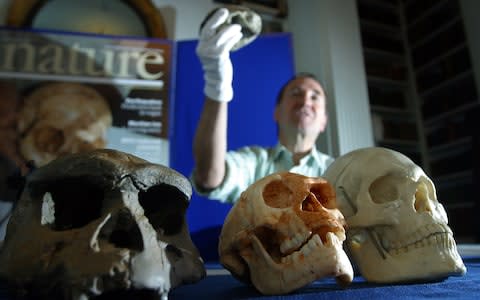Why big brains took a bite out of our ability to chomp

If you have ever struggled to gnaw your way through a fatty chunk of Aberdeen Angus or a forkful of fibrous kale, then take heart. It is your large brain which is causing the problem.
While other omnivores evolved powerful biting muscles as they increased in body size, humans instead poured their developmental resources into more cerebral matters.
In the space where muscles critical for hard biting should be housed, humans grew bigger brains and with the extra thinking capacity, invented cooking, which made food softer, further diminishing the need for bone-crushing jaws.
The new findings were uncovered by researchers at the universities of Reading and Lincoln who used computer analysis to study bite force data from 434 species, both extinct and living, including reptiles, birds and mammals.
Dr Manabu Sakamoto, biological scientist from Reading and lead author of the study, said: “Our study shows that the evolutionary lineage leading up to modern humans was associated with a rapid decrease in bite force.
“This fits with previous studies showing a similar rapid reduction in molar tooth size in ancient humans, but also coincides with the enlargement of the brain along with the invention of cooking.
“As the brain got larger, our ancestors lost the necessary space to house powerful jaw closing muscles - so we can say that we lost the ability to bite and chew hard as a trade-off for acquiring a bigger brain.”
The team originally thought that animals with the most powerful bites were forced to rapidly evolve the feature because of a change in their diets.

But instead found that the bite power of most animals developed proportionally to evolutionary changes to their body size over time, with only some seeing their bite forces develop at a faster rate than other changes.
In fact, more dramatic reductions were seen over time than increases, with humans being a prime example.
Dr Sakamoto added: “Increasing brain size in humans may be the reason that our bite power is pretty pathetic.
“Once we learnt to cook food, bite power became even less important. In effect, we evolved the cooking pot as our way of making our food easier to swallow. This is in line with other studies showing that humans chew their food less than other animals.”
The team also made some intriguing discoveries about the bite capabilities of other animals.
For example Tyrannosaurus rex, which was renowned for being one of the most fearsome creatures to have ever lived, evolved a bite that was less impressive in relation to its body size than a tiny Galapagos ground finch.
For its body size, T.Rex had a bite force of 57,000 Newtons that was utterly unremarkable for its body mass of eight tonnes.
Yet a Galapagos large ground finch can bite with an impressive 70N of force, despite weighing just 33 grammes, about 320 times more powerful, pound-for-pound, than the huge dinosaur.
Dr Chris Venditti, University of Reading co-author on the study, said: “Our research provides new insight into the latest theories about the speed and drivers of evolution. It also allows us to create some fascinating hypothetical match-ups.
“The proclaimed ‘King of the Dinosaurs’ would be no match for a finch in a fight, if they were the same size.”
Dr Sakamoto added: “Large predators like T. rex could generate enough bite force to kill its prey and crush bone just by being large, not because they had a disproportionately powerful bite.
“This counters the idea that an exceptionally strong need for a powerful bite drove these ancient beasts to evolve bone-crushing bite forces.”
The research was published in Proceedings of the Royal Society B.

